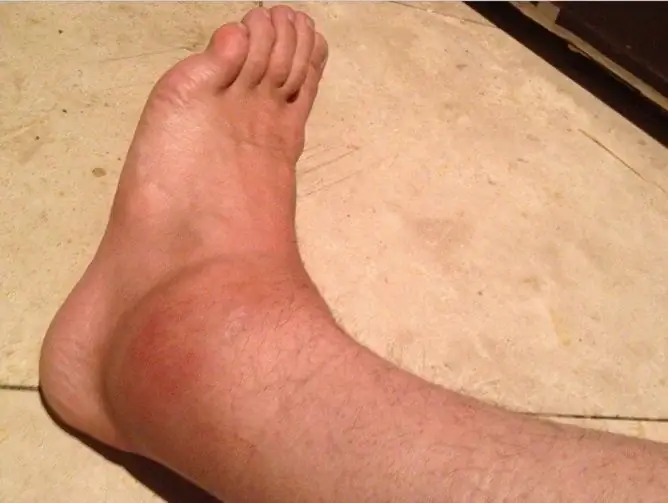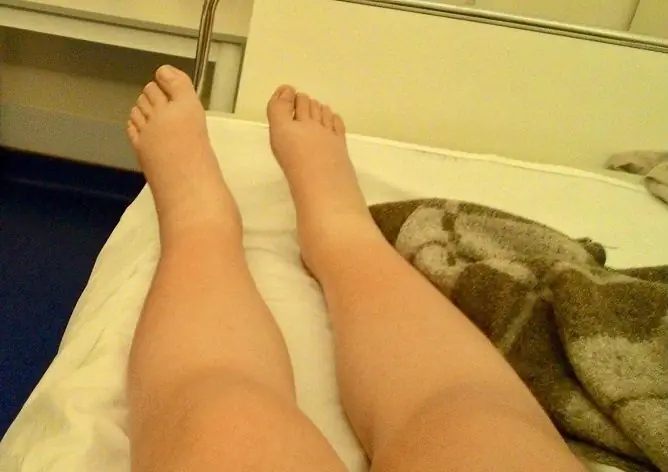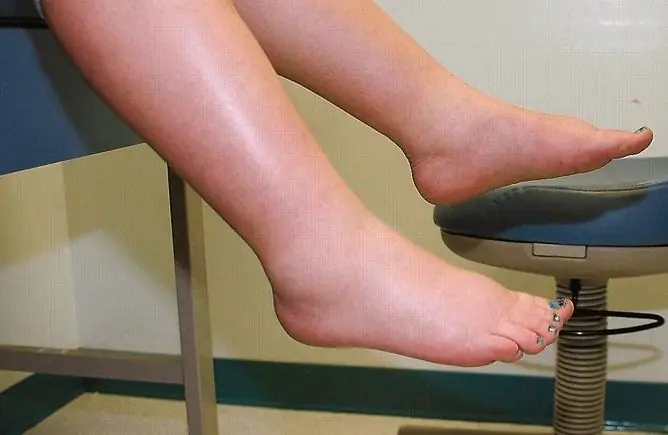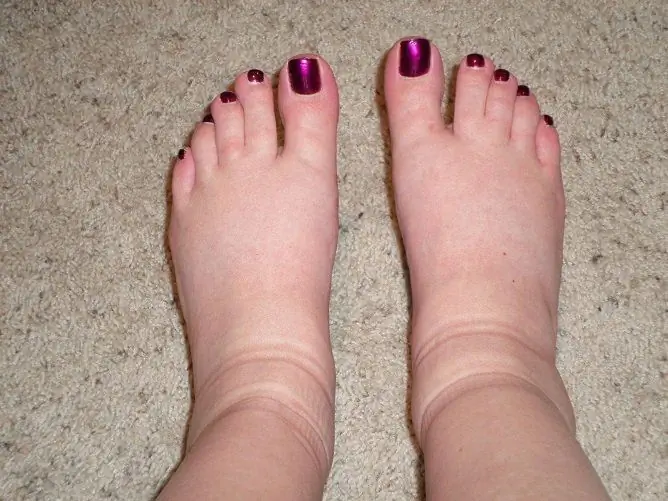- Author Rachel Wainwright [email protected].
- Public 2024-01-15 19:51.
- Last modified 2025-11-02 20:14.
Swelling of the legs in the ankle and foot: why the legs swell in the ankles and what to do
The content of the article:
-
Why do legs swell in the ankles
- Lifestyle
- Footwear
- Metabolic disorders
- Pregnancy
- Trauma
- Diseases of blood vessels and internal organs
- Kinds
- Diagnostics
- Treatment
- Folk remedies
- Prevention
- Video
Men and women often encounter the problem of swelling of the legs in the ankle and foot. Puffiness often appears by the end of the day and the reasons for its occurrence are far from always being in any diseases of the vessels or internal organs.

Swelling of the ankle and foot is often traumatic
Why do legs swell in the ankles
There are many factors that lead to foot swelling. Let's consider them in more detail.
Lifestyle
In many cases, the swelling of the lower extremities is due to the following lifestyle features:
- Drinking a lot of fluids. The excess fluid lowers the osmotic pressure of the blood, and as a result, plasma begins to sweat through the capillary walls into soft tissues. That is why in summer people often notice swelling of the feet.
- Sedentary work. If a person is in a sitting position for a long time, then his blood outflow from the lower extremities worsens due to compression of the veins.
- Significant physical activity. Excessive engagement in some sports (strength exercises, jogging, walking, yoga) is accompanied by microtraumas of muscles and ligaments, which leads to the development of traumatic edema.
- Salty food abuse. An excess of salt contributes to an increased feeling of thirst and a person begins to drink a lot. The kidneys do not have time to excrete excess fluid, and it accumulates in the body.
Footwear
In women, high-heeled shoes are often the cause of swelling of the legs in the ankle and foot area. When wearing it, the leg is in an unnatural position, in addition, an additional load is exerted on the foot, associated with a shift in the center of body mass. It is impossible to recognize physiological and shoes without a heel. It increases the stress on the arch of the foot and thus provokes the appearance of puffiness, which can cover not only the foot, but also the ankle.
Metabolic disorders
Ankle swelling is often caused by obesity. Excess body weight significantly increases the load on the joints of the lower extremities and thereby leads to the development of deforming osteoarthritis, one of the symptoms of which is swelling of the lower extremities.
Pregnancy
Puffiness during pregnancy can be associated with both physiological and pathological causes. Physiological reasons include:
- compression of veins by an enlarged uterus;
- increase in body weight;
- changes in hormonal balance.
In the second half of pregnancy, women may develop OPG-gestosis, one of the symptoms of which is swelling of the extremities. This condition poses a potential threat to the life and health of the expectant mother and the development of the fetus. Therefore, if even a slight swelling of the lower extremities of a pregnant woman appears, you should immediately consult a gynecologist.
Trauma
Any leg injuries cause damage to the integrity of the blood vessels. Blood enters the intercellular space, which causes the onset of an aseptic inflammatory process, which leads to the appearance of edema.
Diseases of blood vessels and internal organs
If swelling of the lower extremities occurs frequently and persists for a long time, then this often indicates the presence of serious pathology in the human body:
- diabetes mellitus;
- thrombophlebitis;
- lymphostasis;
- heart failure;
- renal failure.
But the most common cause of persistent leg edema is varicose veins of the lower extremities.
Kinds
Depending on the etiological factor, experts distinguish several types of edema of the lower extremities:
| View | Causes of occurrence | Clinical features |
| Stagnant | Associated with an increase in venous pressure and increased permeability of the vascular walls. Usually observed with thrombophlebitis and varicose veins. |
Initially, they appear only in the evening, and by the morning, after a night's rest, they disappear on their own. In the future, they are saved permanently. The swelling is uneven. To a greater extent, it is observed near the affected veins. Congestive swelling is usually combined with a feeling of heaviness in the limbs, sometimes the legs may hurt. With varicose veins and thrombophlebitis, usually initially only the left or right leg swells, where the pathological process is most pronounced. |
| Hydremic | They are caused by impaired renal excretory function (acute and chronic glomerulonephritis, acute and chronic renal failure). | They persist for a long time. Often combined with an increase in blood pressure, proteinuria, increased blood urea and creatinine. |
| Neuropathic | Uncompensated diabetes mellitus and alcoholism. In these diseases, the nervous innervation of the vascular wall tone is disturbed, which contributes to blood stagnation, sweating of plasma into soft tissues. | The anamnesis contains indications of alcohol abuse, diabetes mellitus. |
| Cachexic | They occur in patients with severe anemia, protein starvation, and in the terminal stage of malignant tumors. | The general exhaustion of the patient is noteworthy. |
| Allergic | Contact with a substance to which a person has an increased sensitivity. | Puffiness is combined with itching, redness of the skin, and the appearance of a rash. |
| Mechanical | Caused by mechanical compression of blood vessels, such as a tumor. | A gradual increase in puffiness is characteristic. |
Diagnostics
You should consult a doctor in case of frequent occurrence of edema of the lower extremities and with their persistent nature. The doctor will conduct an examination and prescribe the examination necessary in each specific case, which may include:
- general blood analysis;
- general urine analysis;
- urine analysis according to Zimnitsky and Nechiporenko;
- biochemical blood test to determine the concentration of glucose, total protein, urea, creatinine, cholesterol, uric acid;
- determination of hormonal status;
- ECG and Echo-KG;
- duplex scanning of the vessels of the lower extremities;
- angiography of the vessels of the lower extremities;
- computed or magnetic resonance imaging.
Based on the results of the examination, the doctor can refer the patient for consultation to narrow specialists (vascular surgeon, oncologist, endocrinologist, nephrologist, cardiologist).
Treatment
Medication therapy is prescribed only by a doctor. Patients should understand that it is necessary to treat the underlying pathology, and not its external manifestations in the form of swelling of the tissues of the lower extremities.
With edema associated with kidney and heart disease, the appointment of diuretics, potassium preparations and cardioprotectors is indicated.
At the initial stages of varicose veins disease are prescribed:
- venotonics (Venarus, Detralex);
- antiplatelet agents (Cardiomagnyl, Eskuzan);
- angioprotectors (Askorutin, Troxevasin).
To reduce the severity of symptoms, ointments with venotonic or heparin can be used topically. They are applied in a thin layer to the skin in the affected area. At the same time, you cannot massage the skin strongly.
With advanced varicose veins, when the patient's trophic processes in the soft tissues of the lower extremities are disturbed and drug therapy does not have the desired effect, surgical treatment is indicated (laser surgery is often used). Its performance is well shown in photos before and after the operation.
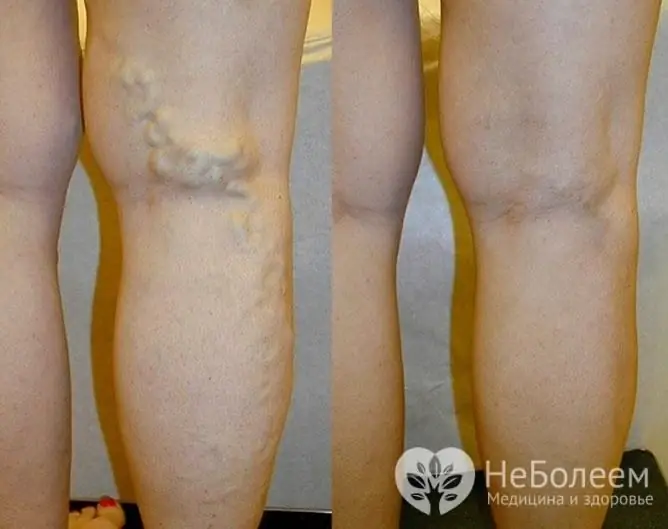
Leg condition before and after laser treatment of varicose veins
Folk remedies
By agreement with the attending physician, traditional medicine can also be used in the complex therapy of venous diseases:
- Rosehip infusion. Put 2 handfuls of rose hips in a thermos and pour 2-2.5 liters of boiling water over them. Insist 6-8 hours. Take a glass 2-3 times a day. The substances contained in rosehip berries help to normalize the permeability of the vascular walls, improve their tone.
- Infusion of hawthorn. Pour a tablespoon of chopped hawthorn fruit with a glass of boiling water. Insist 15 minutes, drain. Take half a glass three times a day half an hour before meals. Hawthorn berries reduce blood viscosity, have a venotonic effect.
- Infusion of licorice root. It has an angioprotective, antispasmodic and anti-inflammatory effect. Lightly fry one teaspoon of chopped roots in a pan and pour a glass of boiling water. Insist 6 hours. Strain and take half an hour before meals 2-3 times a day for a third of a glass.
- Horse chestnut seed tincture. It can be purchased at the pharmacy chain. Improves the processes of microcirculation, has an angioprotective, anti-inflammatory and antispasmodic effect. Take 10 drops 3 times a day before meals.
Prevention
To prevent swelling of the ankles, ankles and feet, follow these guidelines:
- refuse to wear tight shoes for a long time, as well as shoes with high heels or with thin soles;
- when sedentary work, take short breaks every 2-3 hours to perform simple physical exercises and self-massage of the legs;
- while sleeping, put a small roller or pillow under your feet;
- include in the diet a sufficient amount of vegetables and fruits, foods high in potassium;
- to live an active lifestyle;
- timely identify and treat systemic diseases.
Video
We offer for viewing a video on the topic of the article.

Elena Minkina Doctor anesthesiologist-resuscitator About the author
Education: graduated from the Tashkent State Medical Institute, specializing in general medicine in 1991. Repeatedly passed refresher courses.
Work experience: anesthesiologist-resuscitator of the city maternity complex, resuscitator of the hemodialysis department.
Found a mistake in the text? Select it and press Ctrl + Enter.

